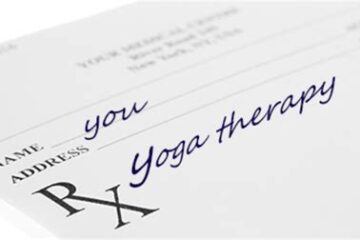Most of us are aware of the basics of Yoga, at least, about the external form of yoga which is the Yogasanas and Pranayama. However, often we find that people are not aware of the difference between Yoga and Yoga therapy hence they are confused about what is suitable for them. Many people refrain from going to yoga sessions because they think it is for flexible people who are willing and can do extreme positions. This is not true. Yoga is for everyone. You just need the right instructor who can guide you to do the right postures at the right time.
How is Yoga Therapy different from Yoga?
Yoga therapy can be practised by anyone at any age and any stage. There is a classical form of Yogasanas in which no props are used. Asanas are done all by yourself, whether it involves balancing, back bends, forward bends, spinal rotations, alignment or weight-bearing positions. It has to be practised and performed with the help of your flexibility and muscle strength. There is an expectation that the sadhaka should have a reasonably healthy physical condition and a fit body. Whereas in yoga therapy, the doors are open for patients whose physical health is not in the best stage, they might be having various joint pains, anatomical issues due to accelerated degenerative process of body tissues and physiological problems as well. Such people look for a ‘safe practice’!
To start with a yoga therapy session, it is important, rather mandatory to know a client’s medical history in as much detail as possible. A therapist must schedule a consultation with the client. The Yogasanas are chosen for the client which will be best suitable for him to help him with his current physical problems. These problems could be knee pain, lower back pain, sciatica pain, Slipped disc, neck pain (Cervical spondylosis), frozen shoulder, knee arthritis, heel pain, hypertension, diabetes, obesity and many others. If a client comes with any such ailments then he has to be prescribed specific yogasanas. Such yoga sessions are often called Yoga therapy sessions or Restorative Yoga sessions. (to book a consultation at Innersaga, call us at +91 9923844281)
What makes Yoga Therapy safe and effective?
Patients are never pushed beyond their limits to achieve any posture. Utmost attention is given to the yoga sequence that a patient has to follow. Postures which are not suitable for a certain medical condition are strictly avoided unless the therapist wants to derive a certain benefit out of it in a specific case. For example, a patient having Osteoarthritis of the knee must not do Veerbhadrasana, Surya Namskara, jogging etc. However, the therapist may choose to make him practice the veerbhadrasana with the help of a chair or a bench to strengthen his thigh muscles. Usage of a yoga chair will not put any pressure on the knee and yet the quadriceps will be at work.
The asanas are held for a longer duration with the help of props. That helps the muscles in gaining more length than in regular yoga practice of dynamic nature. There is a better possibility of increasing your flexibility in yoga therapy. Yoga therapy or Restorative yoga can be practised by everyone. You need not wait to have a medical requirement to practice it! This form of yoga works more on endurance and is very intense in a different way.
The effectiveness of your therapy session solely depends on the knowledge, acumen and experience of the therapist. Hence you must be careful when choosing one!
Is Yoga therapy different from Rope & belt therapy?
Rope & Belt therapy and Medical yoga are enhancements of Yoga therapy (read more on the highlighted links). Rope & belt therapy works on the alignment of the joints, elongation of the spine and lengthening of the muscles to reduce acute joint pains. It is exceptionally helpful for cases of sciatica pain, lower back pain problems, knee joint problems and cervical spondylosis.
How can a person with a medical condition do Yogasanas?
A person who has a medical condition that restricts him from doing classical yoga postures must go for Yoga therapy sessions. As mentioned above, Yoga Therapy is practised with the help of a lot of props like yoga ropes, cotton bolsters, yoga belts, bricks of different shapes, chairs, yoga blankets and benches of different shapes like vipreet danda bench;setubandh bench; halasana bench. These yoga props help a patient to achieve a posture that he may not be able to do with his muscle strength and flexibility level. These postures are held for 1min to 10 mins. With the help of props, the postures can be easily held for that duration. Yoga Therapy works on improving the body’s postural alignment, relaxation of muscles, and increasing Range of Motion (ROM) by improving flexibility, pain management, improved sleep and improvement in daily routine activities.
Yoga Therapy at InnerSaga
We specialize in rope & belt therapy for joint pain and Medical yoga. We also include emotional healing as a part of therapy. Yoga therapy is meant to take care of basic emotional issues as well however, we don’t find a lot of people practising on those levels. During the consultation at InnerSaga, we go deeper into the emotional state of a client and try to link it back to their physical complaints. Guidance on lifestyle changes is also provided which is not very difficult to follow. Remember, only 20% of change in your lifestyle can improve 80% of your problems!
If we feel that a client will be benefitted from the healing sessions, we recommend it at the time of consultation. The regime to be followed is mutually agreed upon between the client and the therapist. The result-oriented therapy sessions begin thereafter!


0 Comments